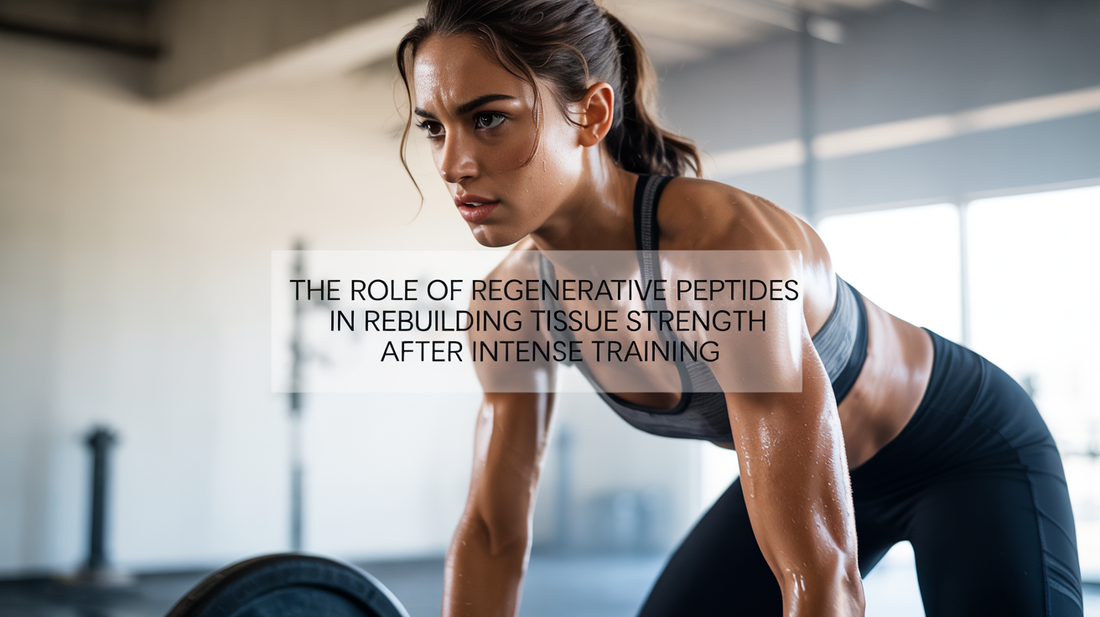
The Role of Regenerative Peptides in Rebuilding Tissue Strength After Intense Training
Share
Regenerative peptide therapy provides targeted support for athletes and fitness enthusiasts aiming to recover after intense training. By accelerating tissue repair and strengthening connective structures, these therapies help the body bounce back faster while maintaining long-term resilience.
The Challenges of Intense Training
Intense workouts place significant stress on muscles, tendons, and ligaments. Without proper recovery, this stress can accumulate and lead to setbacks such as:
- Micro-tears and fatigue buildup that slow down recovery cycles and may lead to persistent soreness if ignored.
- Weakened connective tissue that increases risk of strains, sprains, and overall instability during demanding movements.
- Inflammation and soreness that limit flexibility, reduce joint range of motion, and affect training quality.
- Recurring injuries caused by incomplete healing from prior sessions, which often compound over time.
- Overtraining-related stress that can compromise immune response, further delaying tissue repair.
- Joint stiffness and reduced mobility, making athletic form more difficult to maintain after repeated high-intensity training.
These challenges highlight the importance of adopting recovery strategies that not only reduce pain but also rebuild tissue strength, protect connective structures, and prepare the body to handle future training demands more effectively.
How Regenerative Peptides Support Tissue Strength
Regenerative peptides like BPC-157 and TB-500 work at the cellular level to enhance recovery by:
✅ Stimulating angiogenesis (new blood vessel growth) for improved nutrient delivery to healing tissues.
✅ Enhancing collagen production, reinforcing tendons and ligaments for greater durability and flexibility.
✅ Reducing inflammation, accelerating the healing of micro-tears and minimizing soreness from repetitive stress.
✅ Improving cell migration and repair, allowing tissues to regenerate more efficiently and with stronger structural integrity.
✅ Supporting elasticity and mobility, helping tissues adapt to repeated physical stress and reducing the risk of long-term stiffness.
✅ Promoting balanced tissue remodeling, ensuring muscles and connective tissue rebuild stronger rather than weaker after injury or strain.
These processes help restore not just muscle function but also the underlying connective tissues that provide structural integrity and resilience, ultimately creating a foundation for more sustainable training progress.
Benefits for Athletes and Active Adults
By strengthening tissue at its foundation, regenerative peptides offer several key advantages:
- Faster recovery cycles, reducing downtime between training sessions and enabling consistent schedules. Athletes can return to peak training sooner, maintaining competitive momentum and preventing extended breaks that slow progress.
- Lower injury recurrence, thanks to stronger tendons, ligaments, fascia, and joint support. This not only reduces immediate risks but also supports career longevity by minimizing setbacks that could otherwise accumulate over time.
- Greater mobility and flexibility, enabling better athletic form, smoother movement, and reduced stiffness. Enhanced flexibility allows for a wider range of exercises, more efficient biomechanics, and improved technique.
- Sustained performance, ensuring athletes can maintain high-intensity routines longer with greater confidence in their body’s durability. This sustained performance provides both psychological reassurance and physical readiness for demanding schedules.
- Long-term adaptability, helping the body adjust to new training loads and preventing early burnout. Adaptability also translates into resilience during periods of heavier competition or sudden increases in physical demands.
- Improved joint function and balance, supporting stability during complex movements and reducing the likelihood of compensatory injuries.
- Enhanced recovery mindset, as athletes gain confidence in their body’s ability to repair and strengthen, which often leads to more consistent training habits and higher motivation levels.
Safety and Best Practices
- Medical guidance is essential — peptide use should be tailored to individual health needs and overall fitness goals. Consulting with a qualified healthcare professional ensures correct dosage, monitoring of progress, and avoidance of potential interactions with other supplements or medications. Athletes should have their recovery programs personalized to account for unique training intensity, injury history, and long-term performance goals.
- Quality matters — sourcing from trusted providers ensures purity, safety, and effectiveness in supplementation. Independent lab testing, transparent labeling, and adherence to manufacturing standards further guarantee that products meet expectations for safety and potency. Choosing inferior or unverified sources can reduce effectiveness and pose health risks.
- Consistency counts — long-term benefits come from proper dosing, adherence, and pairing peptides with adequate rest and nutrition. Regularity is key to seeing results, as sporadic use diminishes cumulative effects. Integrating peptides with sound recovery practices such as hydration, stretching, sleep optimization, and balanced nutrition creates a comprehensive recovery system that magnifies their effectiveness.
The Future of Training Recovery
As training loads increase, regenerative peptide therapy is becoming a powerful ally for athletes. By rebuilding tissue strength and resilience, these therapies not only speed up recovery but also prepare the body to handle greater demands with reduced risk of setbacks. They represent an evolving approach to sports recovery, where science-backed support complements traditional rest and rehabilitation methods.
Conclusion: Regenerative peptides play a vital role in rebuilding tissue strength after intense training, making them a promising tool for athletes and active adults who want to train harder, recover smarter, and sustain performance over time while minimizing risks of chronic strain and long-term injury.
